Master Baking Basics: A Beginner’s Guide
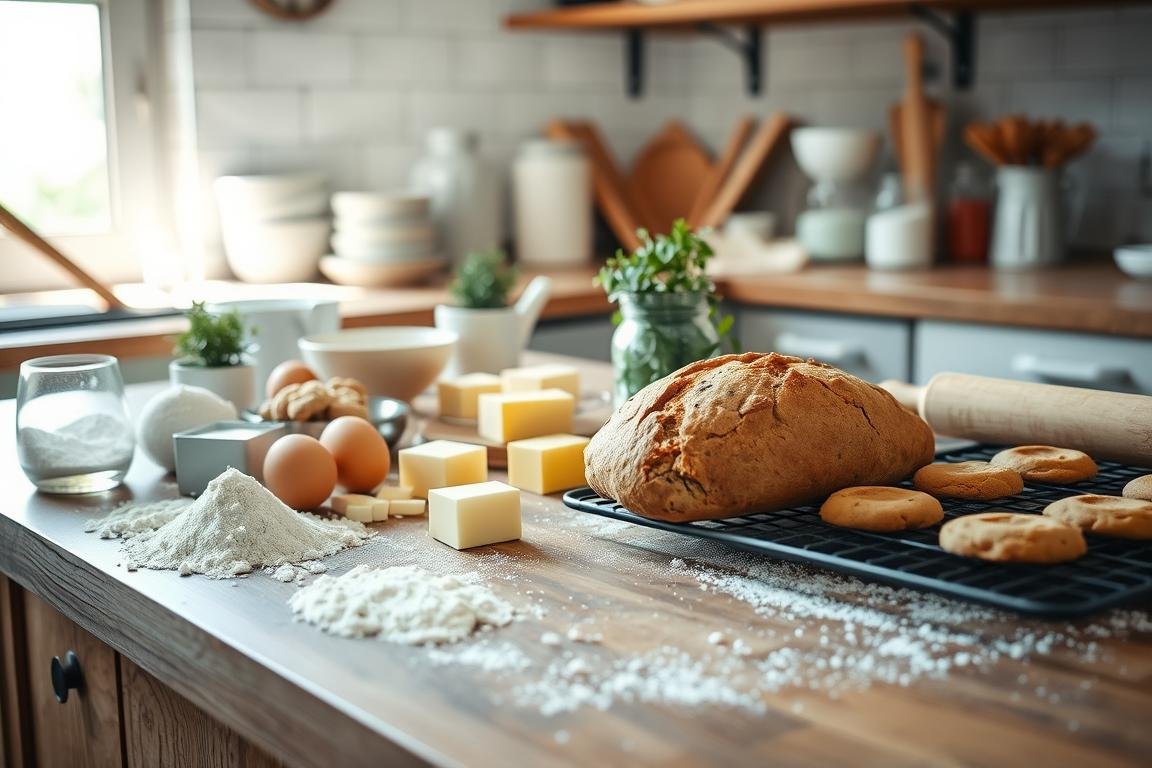
Have you ever wondered why some breads are so perfect and others not? Baking blends art with science. It’s not just for those who love sweets but also for those who prefer savory. Baking turns simple ingredients into amazing foods, like focaccia or tarts. But how do you start baking with the right skills?
Baking is more than just following a recipe. It’s knowing how ingredients work together. With the right basics, you can make many things, like strombolis, cakes, and tarts. Baking Tips help you get better with practice. They show you how to adjust recipes. With the right tools and some creativity, you’re ready to start. Being prepared is your first step to baking something delicious.
Did you know a kitchen scale is better than measuring cups? The secret to great baking might be in how you do it, not just the mix. Starting with basic skills can help you bake like a pro or wow your family. A digital scale gives you more accuracy. Learning about baking science, you’ll see why details matter. Like why you can’t just double a recipe without adjustments.
Key Takeaways
- Understanding the science behind baking is as crucial as having the right tools.
- Creating both sweet and savory baked goods requires a versatile set of baking techniques.
- Using a digital scale for ingredients can greatly improve the precision of your bakes.
- Adjustments are essential when scaling recipes to maintain the intended texture and flavor balance.
- Distinguishing between various baking methods and when to apply them is fundamental for budding bakers.
- Knowing the proper usage of common baking ingredients can make or break a baked masterpiece.
- Recognizing the vital role that temperature and baking times play will guide you towards more consistent and successful results.
Understanding Baking: What You Need to Know
Baking is more than just mixing ingredients. It’s science and art. You need to know Baking Fundamentals. Understanding Baking Science and Baking Math is vital. These help turn basic ingredients into amazing baked goods.
The Science Behind Baking
Baking is all about chemical reactions. Yeast turns sugars into gas and alcohol. This and the Maillard reaction make baked goods golden and tasty. Learning Baking Science ensures great texture and flavor.
Emulsifiers like eggs and butter are key. They mix fat and water smoothly. This knowledge helps make new recipes or fix old ones.
Importance of Accurate Measurements
Accurate measurements are crucial in baking. About 70% of baking fails because of measurement mistakes. Using exact Baking Math helps avoid common problems. It’s important whether you’re weighing ingredients or measuring volume.
Knowing how changing ingredient amounts can affect your baking is part of Baking Fundamentals. For instance, too much baking soda changes a cake’s texture. Using the wrong spoons can cause a 25% increase in failures.
Improving your baking skills involves precision and understanding the science. Paying attention to detail and improving your methods will make your baked goods better. You’ll get tastier, prettier results and become a baking expert.
Essential Baking Tools for Your Kitchen
Starting your baking journey needs the right tools. The many options can seem overwhelming at first. It’s key to pick equipment that fits different recipes and methods. This way, you’ll get great results every time.
Must-Have Baking Utensils
A set of baking utensils is a must for any kitchen. You’ll need things like silicone spatulas and OXO mixing bowls. These tools make tasks like mixing easier and help perfect your baking.
Choosing the Right Bakeware
Finding the right bakeware is important. Silicone baking mats and All-Clad saucepans are great choices. They help your baking turn out well and make cleanup easier too.
Equipment for Baking Success
High-quality tools are key for baking. A KitchenAid mixer and a Breville hand mixer are great helps. Don’t forget an OXO food scale for accurate measurements. Here are some top tools every baker should have:
| Tool Type | Description | Recommended Product |
|---|---|---|
| Bakeware | Nonstick, easy to clean | Kitzini Silicone Baking Mat |
| Mixer | Powerful and efficient for various mixing tasks | KitchenAid Pro Stand Mixer |
| Measuring Tools | Accurate, easy-to-read measurements | OXO Measuring Cup and Spoon Set |
| Hand Mixer | Compact, powerful, and quiet | Breville Hand Mixer |
| Oven Mitts | Superior heat resistance and comfort | Big Red House Oven Mitts |
With these tools, your kitchen will be ready for many baking projects. You’re sure to create delicious treats and enjoy your baking time.
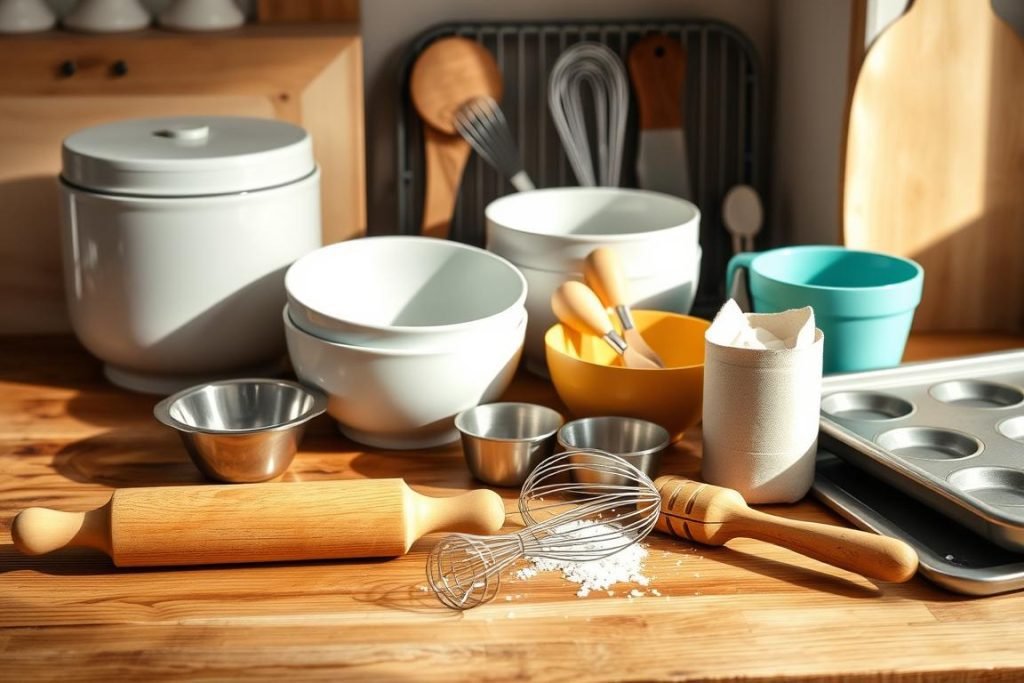
Common Baking Ingredients and Their Roles
Are you just starting or already love baking? Knowing what each ingredient does helps a lot. We’ll talk about how important ingredients work. Plus, some great tips to improve your baking.
Flour Varieties and Functions
Flour is super important. It gives structure and texture to your treats. Different types do different things:
- All-Purpose Flour: It’s very common and works for many recipes. It’s great for both bread and pastry.
- Bread Flour: This one has more protein. It’s perfect for stretchy doughs like pizza and artisan breads.
- Cake Flour: With less protein, it makes cakes and muffins soft and light.
Picking the right flour makes your baking better.
The Importance of Leavening Agents
Leavening agents make things puff up by creating gas. This makes your baked goods soft. There are a few types:
- Baking Soda: This combines with acidic stuff to bubble up quickly. It’s great for quick breads and cookies.
- Baking Powder: It has an acid and base. It starts working when wet and again when hot.
- Yeast: Yeast is alive! It eats sugar and makes gas. It’s used in bread and rolls.
Sweeteners: Types and Uses
Sweeteners aren’t just for making things sweet. They also help with moisture, color, and texture:
- Granulated Sugar: It makes things sweet, fluffy, brown, and stable when whipped.
- Brown Sugar: It has molasses, giving moisture and a deep flavor. Great for cookies and bars.
- Honey: This natural sweetener brings unique flavors and keeps things moist.
Learning about these key ingredients makes baking easier. Whether it’s a simple bread or fancy pastry, using the right stuff matters. You’ll bake like a pro!
Measuring Ingredients: Techniques and Tips
Getting good at measuring ingredients is key in baking. Doing it right means a lot for your bake’s success. Below, find helpful baking tips and tricks. They’ll help you measure the right way, building a strong base in baking fundamentals.
Using Dry vs. Liquid Measuring Cups
Knowing when to use dry or liquid cups is important. Use plastic or metal cups for dry stuff like flour and sugar. Fill the cup, then level it off with something flat. For liquids, use glass or clear cups. This helps you get the right amount. You must look at the measure at eye level on a flat spot.
The Role of Weighing Ingredients
Weighing with a digital scale is often more accurate than using cups. This matters a lot in baking fundamentals where being precise is key. Weighing is great for ingredients that settle or are packed, like baking powder and brown sugar. It makes sure your recipes work out well, every time you make them.

| Ingredient | Volume | Weight (grams/ounces) |
|---|---|---|
| All-purpose flour, unsifted | 1 cup | 125 grams (4 1/2 ounces) |
| All-purpose flour, sifted | 1 cup | 118 grams (4 ounces) |
| Cake flour, unsifted | 1 cup | 118 grams (4 ounces) |
| Cake flour, sifted | 1 cup | 105 grams (3 1/2 ounces) |
| Brown sugar, packed | 1 cup | 200 grams (7 1/2 ounces) |
Taking extra care to measure right really helps your baking, making it better. Always measure with care and bake with joy!
Preparing Your Baking Station
Starting to master baking? First, you’ll need an efficient station. A great setup is key for Baking Basics and Baking Methods. It ensures you have everything needed close by. Being organized helps with safety and hygiene too. This is important for making great food.
Organizing Your Workspace
The idea of everything in its place is crucial. Begin by finding the right height for work, around 30 to 32 inches. This makes work comfy for most people. Then, look at your space and what you might need to add. Here’s what it might cost you:
| Component | Cost Range |
|---|---|
| Surface Materials | $10–$150 per square foot |
| Cabinetry/Cart | $100–$300 per linear foot |
| Appliances | $350–$8,000 |
| Storage Solutions | $100–$1,000 |
| Tools and Equipment | $100–$1,000 |
Cleaning and Safety Considerations
Always start with a clean kitchen. Make sure surfaces and tools are sanitized. This helps avoid food mixing that shouldn’t. Plan for unexpected costs too, about 10-15% extra. Cleaning as you go keeps things neat and stops mistakes.
A neat and safe station is key to good cooking. It lets you focus on improving your Baking Methods and trying new Baking Essentials. And that makes baking fun and rewarding.

Fundamental Baking Techniques You Should Master
Starting your baking journey involves learning key skills. These Baking Techniques for Beginners are vital. They make your treats taste and look amazing. You’ll move from making good to great goodies.
Creaming Method: A Key Technique
The creaming method is very important for cookies and cakes. You beat butter and sugar until light and fluffy. It makes the mixture airy. That helps make your cakes soft instead of dense.
Folding and Mixing Properly
Folding is crucial in Baking Basics. It’s about adding ingredients gently. Whether it’s flour or whipped cream, folding helps keep things light. Use a silicone spatula to do this. It helps keep air in your desserts, making them fluffy.
Kneading Dough for Texture
Kneading dough is key for good bread. It makes the gluten develop. That gives bread a chewy feel and lets it rise right. The way you knead affects your bread’s texture.

These techniques need patience and understanding. Over-kneading makes bread tough. Over-creaming can mess up cakes. These Baking Instructions help you avoid mistakes. They guide you to baking better.
Every baking step is connected. Accurate measuring, correct mixing, and temperature control matter. Work on these basics. Soon, your kitchen will create not just food, but art.
Understanding Baking Temperatures and Times
Getting to know the basics of baking fundamentals is key. Oven temperatures and how long you bake affect how well your dishes turn out. It’s about finding the exact settings to make your baking better.
Importance of Preheating
It’s important to preheat your oven. This makes sure your food cooks through evenly and rises right. A warm oven spreads heat right from the start. This is really important for foods like soufflés and cakes.
Always heat your oven for 15-20 minutes before starting. This makes your foods cook evenly and taste better.
How Oven Temperature Affects Results
The oven’s heat changes how your baked goods turn out. Knowing how hot to bake helps you make perfect dishes every time. For example, cookies need a certain heat for the right crunch and soft middle.
Different foods need different heat settings:
- Cakes, cookies, and cupcakes do well at 325°F-350°F.
- For crunchier cookies and tasty chicken, 375°F-400°F works great.
- Quick bakes like pastries or veggies need a hotter oven, 425°F-450°F.
- For breads and pizzas with a nice rise and crust, 475°F-500°F is best.
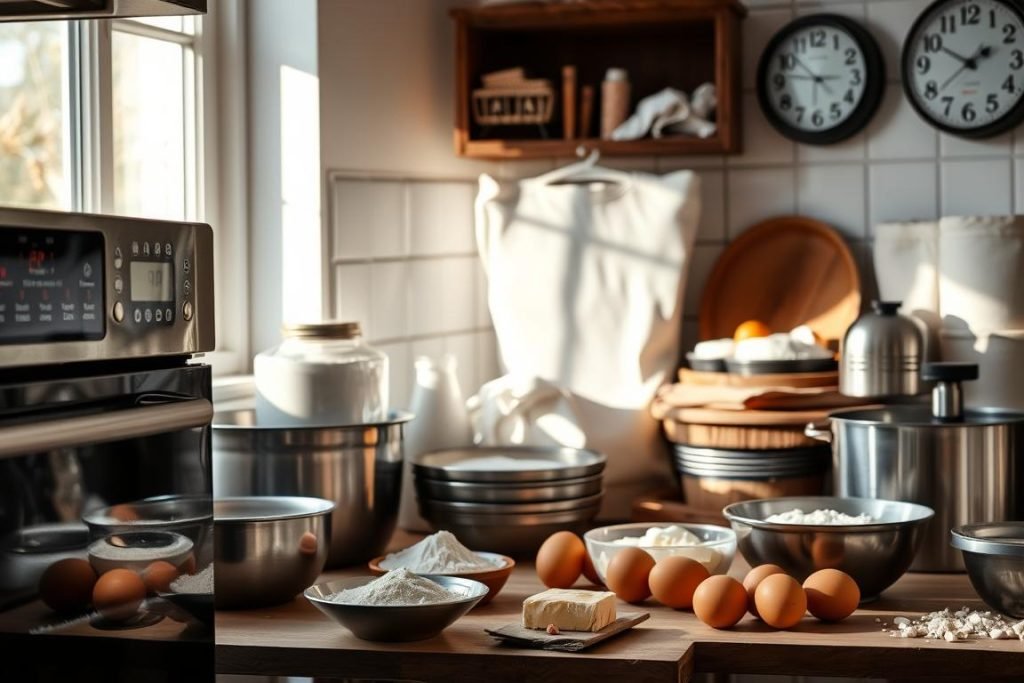
Checking your oven’s heat with a thermometer is important. Ovens can run hot or cold, changing how your bakes turn out.
If you bake at high altitudes, adjust your oven’s heat. Add 15-25°F for every 1,000 feet above sea level. Also, bake for less time. This helps avoid over-rising and undercooking, which happens more up high.
| Baked Good | Temperature | Baking Time |
|---|---|---|
| Cookies | 350°F | 8-12 min |
| Cupcakes | 350°F | 15-20 min |
| Layer cakes | 350°F | 25-35 min |
| Bread loaves | 375°F | 30-45 min |
Using baking fundamentals means you bake with precision every time. Keeping your oven right and understanding heat and time is the secret to great baking.
Baking Different Types of Bread
Starting to bake different kinds of bread is rewarding. It’s a big part of Baking Basics. Let’s look at how quick breads and yeast breads differ. Each kind needs certain Baking Tips to turn out right.
Quick Breads vs. Yeast Breads
Quick breads, like muffins and banana bread, use baking soda or baking powder. They’re quick and easy for anyone looking for Easy Baking Recipes. Yeast breads need live yeast to grow and get puffy. Kneading and letting the dough rise are key steps. It’s vital to know the science to bake perfect yeast bread.
Steps for Perfect Homemade Bread
To make great homemade bread, you need to be precise and know your bread. Here are some top baking tips:
- Proofing: It’s very important for yeast breads. Make sure your dough gets 50% bigger in the final proofing.
- Oven Temperature: Heat your oven to 500°F (260°C) 30 minutes before. This makes sure it’s hot enough for a great crust.
- Baking Vessel: A Dutch oven helps keep steam in and spreads heat evenly. This gives your bread a good flavor and texture.
Every type of bread has its own tastes and textures. They add a lot to a home baker’s skills.
| Type of Bread | Description | Special Note |
|---|---|---|
| Homemade White Bread | Basic, good for sandwiches | Common worldwide |
| Potato Bread | Healthy with added nutrients from potatoes | |
| No-Knead Bread | Easy to make with no required kneading | Popular among beginners |
| Whole Wheat Bread | Nutrient-packed, enhanced flavor | |
| Brioche Bread | French, buttery, soft | Easy to make |
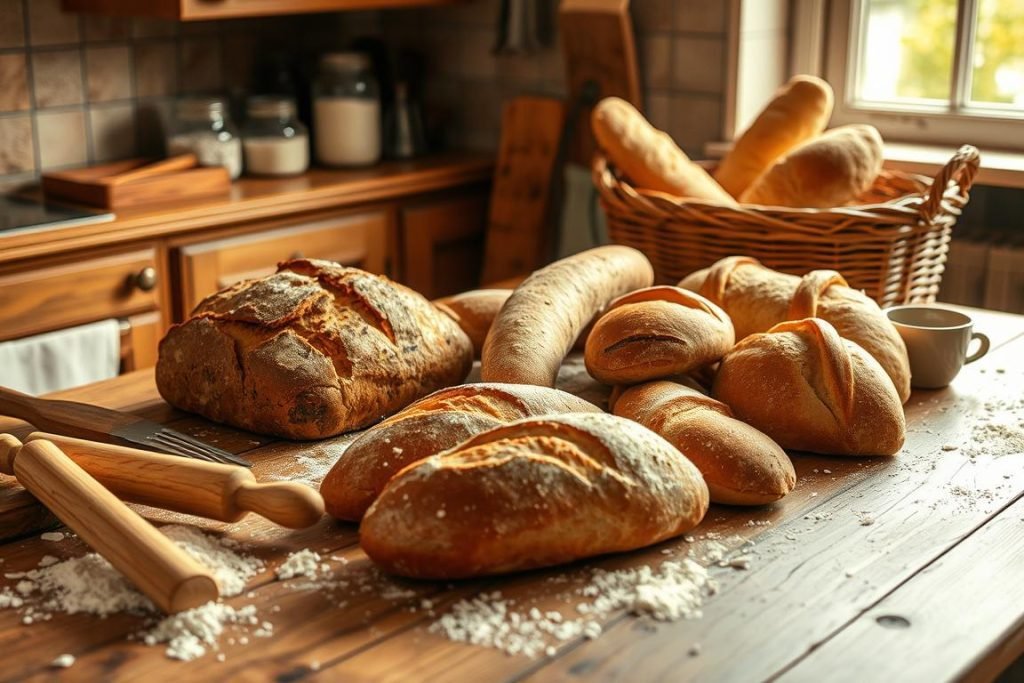
As you try different breads, remember each has its special role. They improve your baking and bring yummy, homemade bread to your table. Whether you’re making quick biscuits or a fancy French brioche, nothing beats the joy of your own bread coming out of the oven.
Perfecting Cakes: Techniques for Success
Are you new to baking or want to make better cakes? Learning key techniques is essential. Understanding these methods and practicing them can make a big difference. It’s about following basic steps and knowing beginner tips.
Types of Cake Batters
There are many types of cake batter, from buttery pound cakes to light sponge cakes. Each type needs its own mixing way to get the right texture. For example, butter cakes need well-mixed butter and sugar for a soft result. Sponge cakes need eggs beaten well and mixed gently to keep them airy.
How to Frost and Decorate
Decorating a cake starts with smooth frosting. Make sure the cake is cool so the frosting won’t melt. An offset spatula can make it smooth. Then, use your imagination and piping bags for detailed designs.
| Technique | Purpose | Key Tip |
|---|---|---|
| Proper Ingredient Measuring | Avoid baking mishaps like dense or overflowing cakes | Use the spoon and level method for flour |
| Using Correct Cake Pan | Ensure even baking and correct cake height | Stick to the size recommended in the recipe |
| Oven Temperature Accuracy | Achieve consistent baking results | Use an oven thermometer to verify temperature |
| Cake Doneness Test | Ensure the cake is perfectly baked through | Use a toothpick or press lightly to check bounce-back |
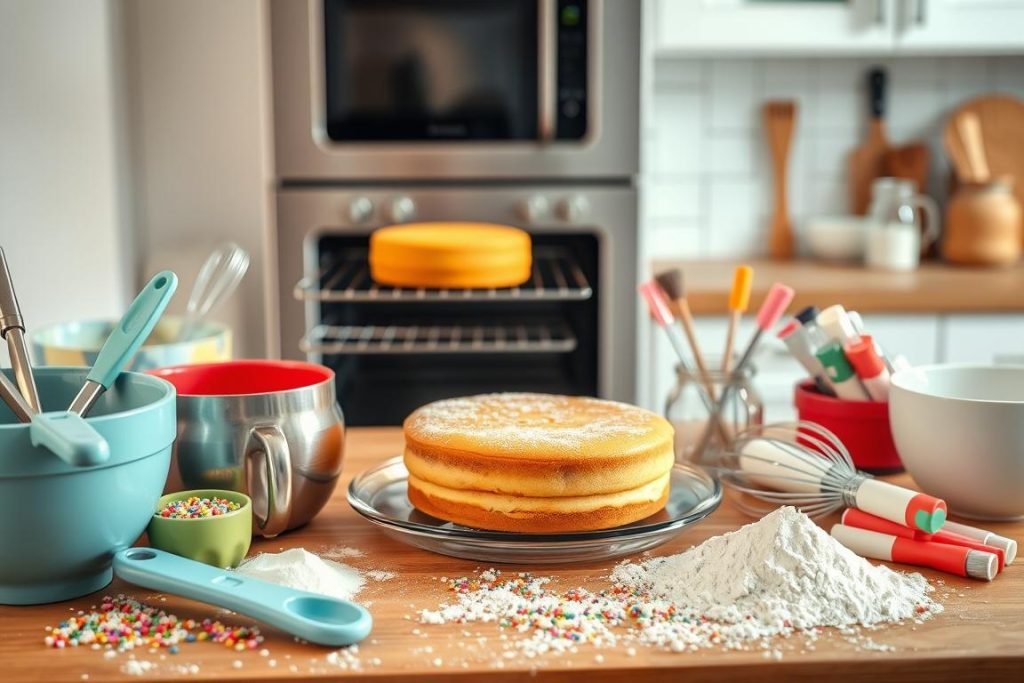
Using these techniques makes cakes look and taste better. It’s great for beginners or those wanting to improve. Knowing the basics helps anyone succeed in baking.
Pies and Pastries: Tips for Perfection
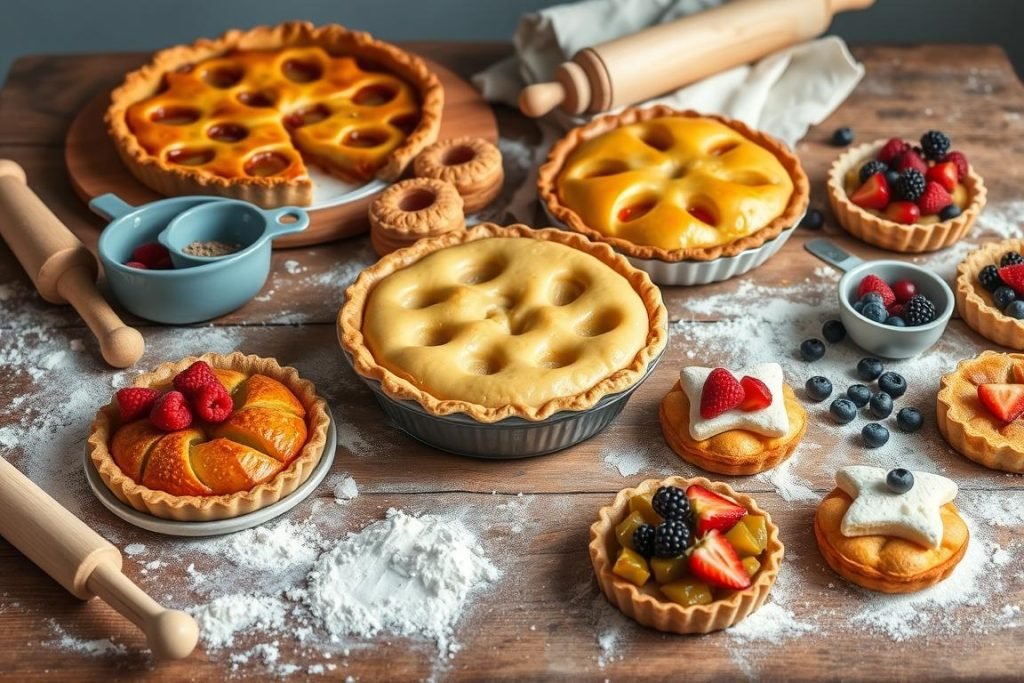
To make perfect pies and pastries, start with learning the Baking Essentials. Knowing the Baking Instructions improves your results. This makes baking fun with Easy Baking Recipes. It’s important to master pie crusts and pastry layers for kitchen success.
Making Pie Crust from Scratch
The best pie crust needs the right flour with about 10% protein. Gold Medal Blue Label flour is great for dough. It balances starch and gluten well. Knowing that American butter has slightly less milk fat (80%) than European (82%) helps understand texture changes.
Here’s a guide on dough handling:
- Butter should be cold and cut into no smaller than half-inch cubes for flakiness.
- Keep everything cold, aiming for dough between 68° and 72°F for the best consistency.
- Chill dough for two hours before shaping to relax gluten and solidify fat, easing handling.
Tips for Flaky Pastries
For croissants and puff pastries, layering dough with butter is essential. Be precise with folds and rotations, and don’t press too hard. This keeps layers distinct and leads to flaky pastries.
| Pie Baking Essentials | Why It Matters | Your Baking Success |
|---|---|---|
| Ideal butter fat content | Optimal fat levels maintain layer integrity for a light texture. | Choosing butter with 80% to 82% fat gives the best texture. |
| Temperature control | The right temperatures keep butter solid, preventing layer fusion. | Use thermometers to keep temperatures in check. |
| Preparation techniques | Chilling, rolling, and folding create flaky pastries. | Master these techniques for flaky pastry success. |
Mastering pies and pastries goes beyond Easy Baking Recipes. It’s about using the Baking Instructions and Baking Essentials. Every step, from picking flour and butter to temperature control, is crucial. Remember, baking’s beauty is in the precision and patience for each recipe.
Troubleshooting Common Baking Issues
Even top bakers face challenges that can turn a great recipe into a letdown. Knowing Baking Fundamentals helps you find and fix problems ahead of time. Let’s learn how to keep our baking skills sharp.
Identifying Problems in Your Baked Goods
Finding out what went wrong is step one in Baking 101. Did your cake fall or cookies harden? These issues often come from small mistakes, like wrong measurements or oven heat. Here’s what to look for and what it might mean:
- Cakes cracking on top often signal an oven temperature that’s too high.
- Dense or deflated cakes might be the result of overmixing butter and sugar.
- Undercooked centers in baked goods could indicate the use of glass baking pans, which conduct heat poorly.
- Cookies that spread too much or not enough might be traced back to the creaming of butter and sugars, or the dough’s temperature.
Solutions for Common Baking Failures
Making small changes in your techniques can improve your baking. Here are some Baking Tips for frequent mistakes:
| Issue | Cause | Solution |
|---|---|---|
| Collapsed Cake | Expired leavening agents | Replace leavening agents every 6 months |
| Overdone Edges | Dark metal pans | Switch to lighter colored baking pans |
| Undercooked Centers | Incorrect oven temperature | Use an oven thermometer to confirm settings |
| Tough Cookies | Over-mixing dough | Mix on a slower speed and combine wet and dry ingredients separately |
| Burned Cookies | Oven too hot or over-baking | Adjust oven temperature and baking time |

Expanding Your Baking Skills: Next Steps
Now that you know the basics of baking, it’s time to try harder recipes. You can start making detailed cake sculptures. Or you might want to learn how to make artisan breads. Both need creativity and a deeper understanding of baking chemistry.
Exploring Advanced Techniques
To get better at baking, start by weighing your dry ingredients. This helps you get consistent results. Use the spoon and level method for accuracy. Also, make sure your butter and eggs are at room temperature. This is very important.
Mix your ingredients gently to keep the texture soft. Know the difference between baking soda and powder. They both have special roles in baking. Always check your oven’s temperature too. This helps prevent baking mistakes.
Resources for Continued Learning
Keep learning by taking advanced baking classes. You can also read books by famous chefs and bakers. Online forums are great for finding tips and meeting other bakers. Use high-quality ingredients like King Arthur Flour and Land O’ Lakes butter for the best results.
With the right resources and dedication, you’ll master the finer details of baking. This includes how to prepare pans and pick the right bakeware. With practice, baking will become easy and fun.